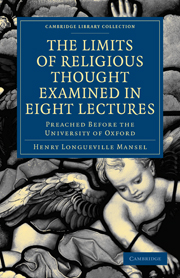 The Limits of Religious Thought Examined in Eight Lectures
The Limits of Religious Thought Examined in Eight Lectures Book contents
EXTRACT FROM THE LAST WILL AND TESTAMENT OF THE REV. JOHN BAMPTON
Published online by Cambridge University Press: 29 August 2010
Summary
—“I give and bequeath my Lands and Estates to the Chancellor, Masters, and Scholars of the University of Oxford for ever, to have and to hold all and singular the said Lands or Estates upon trust, and to the intents and purposes hereinafter mentioned; that is to say, I will and appoint that the Vice-Chancellor of the University of Oxford for the time being shall take and receive all the rents, issues, and profits thereof, and (after all taxes, reparations, and necessary deductions made) that he pay all the remainder to the endowment of eight Divinity Lecture Sermons, to be established for ever in the said University, and to be performed in the manner following:
“I direct and appoint, that, upon the first Tuesday in Easter Term, a Lecturer be yearly chosen by the Heads of Colleges only, and by no others, in the room adjoining to the Printing-House, between the hours of ten in the morning and two in the afternoon, to preach eight Divinity Lecture Sermons, the year following, at St. Mary's in Oxford, between the commencement of the last month in Lent Term, and the end of the third week in Act Term.
“Also I direct and appoint that the eight Divinity Lecture Sermons shall be preached upon either of the following subjects—to confirm and establish the Christian Faith, and to confute all heretics and schismatics—upon the divine authority of the Holy Scriptures—upon the authority of the writings of the primitive Fathers, as to the faith and practice of the primitive Church—upon the Divinity of our Lord and Saviour Jesus Christ—upon the Divinity of the Holy Ghost—upon the Articles of the Christian Faith, as comprehended in the Apostles' and Nicene Creeds.
- Type
- Chapter
- Information
- The Limits of Religious Thought Examined in Eight LecturesPreached before the University of Oxford, in the Year M.DCCC.LVIII on the Foundation of the Late Rev. John Bampton, pp. iii - ivPublisher: Cambridge University PressPrint publication year: 2009First published in: 1867
